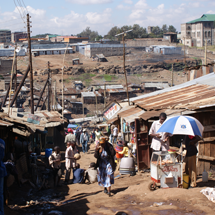
|
| Nairobi, Kenya: A slum in need of infrastructure and services to support the community. |
[25 May 2010] -- On 14 May, the Manager of the Cities Alliance, William Cobbett, gave a presentation to Canberra staff on urban poverty reduction. He said that better urban planning and upgrading slums can pull large populations out of poverty and can help address the challenges presented by climate change.
In the context of MDG Goal 7—Environmental Sustainability, and the fourth target under this goal aimed at achieving a significant improvement in the lives of slum dwellers—Mr. Cobbett provided a brief snapshot of how the developing world is urbanising, and how slums will continue to grow whether they are wanted or formally recognised.
Africa—and the parts of Asia which have not done so—are rapidly urbanising, and as many governments have learned, ignoring or trying to prevent the internal migration and settlement of citizens will not stop the creation of slums. However, urbanisation can be utilised to create development and help people and countries out of poverty.
There are valuable lessons to be learned from the cities of South America where governments, city administrators and donors worked with the people from the slums to provide water and electricity to the places where people choose to live, both initially and as they grow. Not doing so creates substantial risks of poorly regulated markets, corruption and crime.
Failing to respond to urbanisation also creates further generations of slum dwellers, and the past mistakes in the favelas (Brazilian Portuguese for slum) of Latin America are about to be replicated in sub-Saharan Africa, potentially with even worse consequences due to relatively lower incomes and more widespread poverty.
It was discussed how, despite the fact that urbanisation is often viewed as a problem, it can provide a path for growth for developing countries. China, Brazil and also smaller nations in South America, are all examples of how urbanisation has been used by governments as a catalyst for their development. Urban-generated GDP also brings the potential to benefit the entire nation including the rural poor.
The presentation concluded with a discussion about how the debate on addressing climate change is directly linked to the debate on the growth of towns and cities and how haphazard urbanisation exacerbates the challenges associated with climate change.
However, urbanisation can be used to address these challenges by:
-
Setting aside areas of land for services and transport (as successfully applied in Ecuador)
-
Empowering citizens, groups and networks to improve their cities (as done by the women’s union in Vietnam where improvements in infrastructure were generated through microfinance)
-
Avoiding lowering density—which leads to urban sprawl and its own environmental challenges.
This article was first published in the 21 May 2010 issue of AusAID News, the newsletter for AusAID staff.




